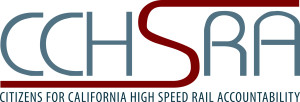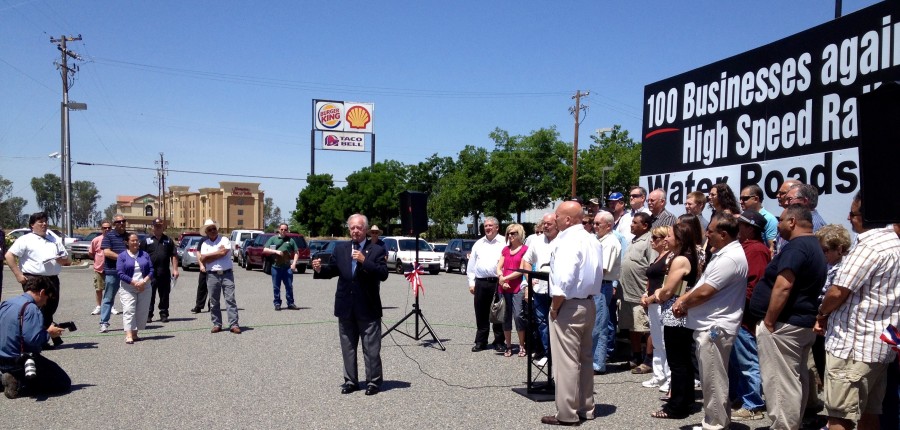California High-Speed Rail Authority Rolls into Labor Day 2021 Asking for More Money
Discussions in the U.S. Congress and in the California State Legislature about providing more public funding for the California High-Speed Rail project now look to continue into the autumn months of 2021. In case you missed the headlines while traveling this summer, below is a news roundup:
High-Speed Rail Opponents Seize on Poll Showing Waning Public Support – San Francisco Chronicle – June 28, 2021
As legislators debate the future of California’s high-speed rail project, results from a public opinion poll showing lackluster voter support has aided skeptics fighting to take money away from the bullet train. The poll, which The Chronicle obtained, was commissioned by the Assembly Democratic Caucus and suggests voters are almost evenly split over whether construction should continue on the 220-mph train. A slight plurality of voters surveyed, 42%, said the state should stop building the high-speed rail system and use the money elsewhere while 41% of voters said construction should continue, according to the polling firm Goodwin Simon Strategic Research.
California Democrats Send Newsom a Budget Without Money for High-Speed Rail – Fresno Bee – June 29, 2021
The conspicuous absence of money for high-speed rail in the $262.6 billion budget bill approved Monday by state legislators in Sacramento could have major consequences for construction work of the bullet-train line in Fresno County and the San Joaquin Valley. The budget bill sent by the state Assembly and Senate to Gov. Gavin Newsom late Monday includes billions of dollars for transportation across the state. But it does not include more than $4 billion sought by the California High-Speed Rail Authority and Newsom to advance work on the high-speed rail project that has been under construction in Fresno, Madera, Kings, Tulare and Kern counties for for seven years.
Own it, L.A. Politicians – You’re Trying to Kill California’s Bullet Train – Commentary in Streetsblog California – June 30, 2021
Three of L.A.’s supposedly ‘environmentalist’ politicians just signed a letter proving once and for all that they want HSR dead in its tracks…They need to own it: this letter makes it screamingly obvious that they have aligned themselves with oil-funded Republicans, such as House Minority Leader Kevin McCarthy, who just want high-speed rail to die. Remember, the money that is the topic of Rendon’s letter is the same previously approved grant that Republicans tried to jam up during the Trump Administration. While ultimately unsuccessful, it caused delays and helped jack up the costs of the project even further.
Brightline Buys Land for High-Speed Rail Terminal – Las Vegas Review-Journal – July 6, 2021
Brightline West has purchased a 110-acre parcel of land on Las Vegas Boulevard South to be home to the Southern Nevada terminal station for the planned high-speed rail line to Southern California, the company announced Tuesday…Clark County Commissioner Michael Naft called the announcement “a significant step forward on our path to securing high-speed rail to Southern California…The road to California is simply insufficient to meet the needs of our booming travel economy.” Company projections call for 11 million passengers to travel between Las Vegas and Southern California per year once the project is completed.
California High-Speed Rail, City of Palmdale Announce Partnership to Advance Palmdale Station Planning – California High-Speed Rail Authority Press Release – July 12, 2021
The Authority entered into an agreement this past week with the City of Palmdale to supply matching funds for a grant application to the U.S. Department of Transportation’s Rebuilding American Infrastructure with Sustainability and Equity (RAISE) program…The Authority is requesting a $1.35 million RAISE grant to fund development of the Master Plan for the integrated, multimodal future Palmdale high-speed rail station. The RAISE funding would enable the Authority, in close collaboration with the City of Palmdale, to advance conceptual design of a world-class rail and transit center in downtown Palmdale.
Legislative Dithering Could Blow Up Bullet Train – Commentary in Streetsblog California – July 13, 2021
In the budget update to its board of directors, agency staff announced it is preparing for a future where funding is held back, endangering tens of thousands of jobs…Workers, as those seen above, will be laid off…cavalier with tens of thousands of jobs…The country’s signature transportation project to combat climate change will be indefinitely delayed, just as funds are becoming available in Washington to complete the project – exactly the situation these same legislators once claimed they were waiting to see materialize.
Will Bullet Train Survive Budget Wrangle? – Commentary by Dan Walters in CalMatters – July 14, 2021
California’s budgetary package is slowly dribbling out of the Capitol but one big issue, the fate of the state’s bullet train project, is still up in the air.
California High-Speed Rail Welcomes Sen. Alex Padilla, Rep. Jim Costa to Central Valley Construction – California High-Speed Rail Authority Press Release – July 16, 2021
The significance of the project, local economic impact and need for federal funding were among topics discussed by Sen. Padilla and Rep. Costa when talking to labor representatives, small business owners and regional economic development leads today.
Jim Costa, Alex Padilla Optimistic About Securing Federal Money for California Bullet Train – Fresno Bee – July 17, 2021
California High-Speed Rail Authority board chairman Tom Richards, a Fresno developer, told Padilla and Costa that federal help is sorely needed for the project that faces an acute shortage of money for ongoing construction beyond the work taking place on the route in Fresno, Madera, Kings, Tulare, and Kern counties. “We are at a point now where we are looking for a tremendous amount of support from both the state of California and the (federal) government,” Richards said.
U.S. Senators Tell California Lawmakers to Stop Effing with Bullet Train – Commentary in Streetsblog California – July 20, 2021
California’s Senators, Alex Padilla (pictured above, left, touring high-speed rail construction in the Central Valley last week) and Dianne Feinstein, came down hard Monday on state lawmakers’ continued gas-lighting and obstructionism over funding for California’s bullet train project from Los Angeles to San Francisco via the cities of the Central Valley.
Congressman Valadao Speaks out Against High Speed Rail Project (Press Release) and Congressman David G. Valadao Speaks out Against High Speed Rail (via YouTube) – U.S. Representative David Valadao – July 20, 2021
The California High Speed Rail has disastrously strained local, state, and federal resources. The project’s cost continues to soar past its original evaluation while its promised range shrinks. As the California High-Speed Rail Authority continues to manipulate its project’s scope, Central Valley communities and farmers suffer under the Authority’s neglect. Last week, I spoke in support of an amendment to prevent High Speed Rail from receiving federal grant funding that could otherwise go to far more deserving projects.
Senator Padilla and Congressman Costa Visit HSR – California High-Speed Rail Authority via YouTube – July 21, 2021
U.S. Senator Alex Padilla and Congressman Jim Costa visited HSR construction in the Central Valley to emphasize continued Federal support for funding clean, electrified rail in California and around the country…”There is no book in America on how to build High Speed Rail. We are writing that book today”
Bullet Train Budget Battle: Should California Spend More on Urban Transit, Not High-Speed Rail? – Commentary by Dan Walters in CalMatters – July 22, 2021
Gov. Newsom wants $4.2 billion to finish the Central Valley link for the bullet train, but legislators aren’t sold. The governor and fellow Democrats are negotiating whether to spend more on urban transportation projects…The Newsom administration, however, praises high-speed rail as a job creator in the economically-struggling Central Valley.
Senate Approves Biden’s Bipartisan Infrastructure Bill with Funds for California – Los Angeles Times – August 10, 2021
…the California High-Speed Rail Authority is already eyeing pockets of money it can apply for to fund its rail project between San Francisco and Los Angeles. Authority spokeswoman Melissa Figueroa said the agency sees about $20 billion to $40 billion in the bill that it could be eligible to compete for and, pending finality of the legislation, plans to apply. “The message that we’re getting out of the federal government is that they want to invest in clean, green electrified rail and high speed rail, and that’s what we’re under construction on here in California,” she said. “That’s the direction we think they want to go, and that makes us very competitive.”
High-Speed Rail Funding Sidetracked in Bipartisan Infrastructure Bill – The Bond Buyer – August 10, 2021
High-speed rail, championed by President Joe Biden on the campaign trail, was shunted to the sideline in the $1.2 trillion infrastructure package approved by the Senate Tuesday…That doesn’t mean the California project, where construction is underway on a 120-mile stretch between Wasco and Madera in the Central Valley, will automatically come out empty-handed. “I don’t think California High Speed Rail has been locked out of the bill,” said Marc Joffe, a senior analyst with the Reason Foundation. “There is $12 billion of non-Amtrak intercity grants available in this bill. They could get something on top of the $3.5 billion the federal government already granted, but it would be a fraction of the $12 billion because the federal government usually wants to divide the funding among the states so not enough to finish the project,” Joffe said. The costs for California’s massive high speed rail project that have soared to $100 billion has lukewarm support in its home state as well.
Dyer Plugs High-Speed Rail During Biden’s Infrastructure Roundtable – The San Joaquin Valley Sun – August 11, 2021
Dyer also called Fresno “ground zero” for high-speed rail and said federal assistance for the project is essential. “We kind of had Fresno in mind,” Biden said in regards to high-speed rail and air quality issues.
Authority Board Approves High-Speed Rail Line Between Bakersfield and Palmdale – California High-Speed Rail Authority Press Release – August 19, 2021
The action paves the way for full California Environmental Quality Act (CEQA) clearance of nearly 300 miles of the high-speed rail project’s 500-mile Phase 1 alignment from San Francisco to Los Angeles/Anaheim. The Board’s actions mark the first CEQA certification of an environmental document in the Southern California region.
“Today’s approval represents another major milestone for this project as we move the project into Los Angeles County,” said CEO Brian Kelly. “We appreciate the collaboration with our local and regional partners as we work to build a clean, electrified high-speed rail system that will connect our state for generations to come.”
High-Speed Rail Board Approves Bakersfield-Palmdale Segment. When Will It Get Built? – Fresno Bee – August 23, 2021
The environmental analysis estimates that the route would displace about 243 homes and 231 businesses along the way, as well as require the acquisition of 174 pieces of agricultural land, temporarily occupying about 252 acres of farmland during construction and resulting in the permanent conversion of acres now zoned for agriculture.
Approval of the route opens the door to eventual negotiations by the state with property owners to purchase the land needed to build the line. For the foreseeable future, however, the route is likely to remain a line on the map until the High-Speed Rail Authority can identify the money that would be needed for construction.




